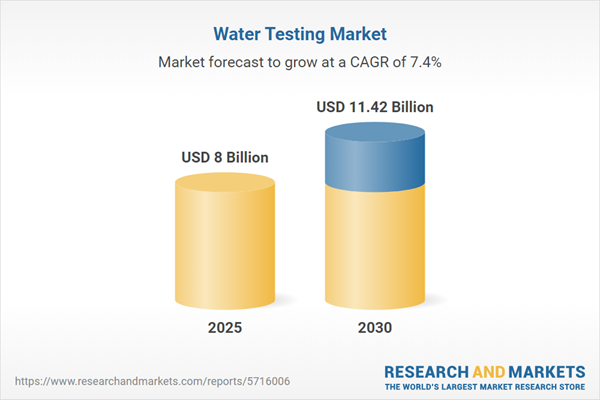Speak directly to the analyst to clarify any post sales queries you may have.
The water testing market is evolving rapidly as organizations worldwide prioritize reliable water quality solutions. Advanced monitoring and analytics are enabling industries to meet stricter safety, regulatory, and operational benchmarks, supporting both public health and environmental resilience.
Market Snapshot: Water Testing Market Growth and Potential
The Water Testing Market grew from USD 7.46 billion in 2024 to USD 8.00 billion in 2025. It is expected to continue growing at a CAGR of 7.36%, reaching USD 11.42 billion by 2030.
This dynamic expansion reflects heightened regulatory scrutiny, emerging contamination concerns, and continuous innovations. Stakeholders across municipalities, industry, and infrastructure seek greater analytical precision and operational efficiency, driving demand for enhanced risk management frameworks and real-time solutions.Scope & Segmentation: In-Depth Coverage of Water Testing Market
- Offerings: Laboratory testing instruments, portable and digital meters, test kits, laboratory testing services, on-site testing services
- Laboratory Instruments: Chromatography equipment, ion selective electrodes, spectrophotometers, TOC analyzers
- Portable & Digital Meters: Conductivity meters, dissolved oxygen meters, multiparameter meters, pH meters, turbidity meters
- Sample Types: Groundwater, potable water, surface water, wastewater
- Test Types: Biological (algae, bacteria, protozoa, viruses), chemical (inorganic and organic compounds), physical, radiological
- End Users: Environmental consulting firms, governmental regulatory agencies, industrial and commercial entities, municipal authorities, private households, research and academic institutions
- Applications: Agriculture and irrigation, aquaculture and fisheries, construction and infrastructure projects, drinking water (bottled and municipal), industrial water testing (chemical processing, manufacturing, oil and gas, power plants), seawater, wastewater treatment
- Regions: Americas (North America: United States, Canada, Mexico; Latin America: Brazil, Argentina, Chile, Colombia, Peru), Europe, Middle East & Africa (United Kingdom, Germany, France, Russia, Italy, Spain, Netherlands, Sweden, Poland, Switzerland; UAE, Saudi Arabia, Qatar, Turkey, Israel; South Africa, Nigeria, Egypt, Kenya), Asia-Pacific (China, India, Japan, Australia, South Korea, Indonesia, Thailand, Malaysia, Singapore, Taiwan)
- Key Companies: ABB Ltd., Agilent Technologies, ALS Limited, Bureau Veritas SA, Ecolab Inc., Emerson Electric Co., Endress+Hauser Group Services AG, Eurofins Scientific SE, HACH India Pvt Ltd. by Veralto Corporation, Intertek Group plc, LuminUltra Technologies Ltd., Mérieux NutriSciences Corporation, Metrohm AG, Myron L Company, Pace Analytical Services LLC, SGS SA, Shimadzu Corporation, Thermo Fisher Scientific Inc., TÜV SÜD AG, Veolia Water Solutions & Technologies SA, Xylem Inc., Anacon Laboratories, Green Solution, R J Hill Laboratories Limited, Merck KGaA
Key Takeaways for Senior Decision-Makers
- Advanced sensing, cloud analytics, and real-time data platforms support rapid response to contamination events and enhance overall operational efficiency.
- Stricter regulatory environments are propelling investment in both modular hardware and validated analytical methods, enabling early detection of emerging pollutants.
- Hybrid service models, which combine centralized laboratory capabilities and on-site diagnostics, offer flexibility and resilience for diverse user needs.
- Supply chain complexity is prompting companies to localize assembly and diversify supplier relationships, leveraging bundled procurement and domestic production.
- Sector growth is underpinned by innovative collaborations—spanning private, public, and research sectors—that accelerate validation and adoption of new water testing chemistries.
- Integrated platforms are aligning hardware, software, and services to support end-to-end water quality management, especially in distributed or rural environments.
Tariff Impact on Supply Chain and Cost Structure
- Recent tariffs have raised costs for imported testing instruments and consumables, intensifying procurement scrutiny and prompting a shift to alternative supply arrangements.
- Service providers are assessing total landed costs and fostering new distributor and OEM collaborations to optimize spending and operational continuity.
- Market players are adopting pay-per-test models, leasing, and long-term supply contracts to maintain budget flexibility amid global trade disruption.
Methodology & Data Sources
This report utilizes a multi-phased methodology, blending extensive literature review, in-depth stakeholder interviews, comparative analysis of product innovations, and case studies. Rigorous data triangulation and peer review ensure validity and actionable insight.
Why This Report Matters: Actionable Value for Industry Leaders
- Guides decision-making on strategic investments in sensor technology, platform integration, and supply resilience.
- Provides segmentation intelligence to support resource allocation, regulatory compliance, and market entry strategies across regions.
- Equips leaders to anticipate market shifts and technological adoption, empowering proactive responses to evolving industry and public demands.
Conclusion
The water testing market is shaped by changing regulations and advancing technology. Leaders equipped with robust insights can achieve operational excellence and sustainable growth in a rapidly transforming landscape.
Additional Product Information:
- Purchase of this report includes 1 year online access with quarterly updates.
- This report can be updated on request. Please contact our Customer Experience team using the Ask a Question widget on our website.
Table of Contents
3. Executive Summary
4. Market Overview
7. Cumulative Impact of Artificial Intelligence 2025
Companies Mentioned
The companies profiled in this Water Testing market report include:- ABB Ltd.
- Agilent Technologies, Inc.
- ALS Limited
- Bureau Veritas SA
- Ecolab Inc.
- Emerson Electric Co.
- Endress+Hauser Group Services AG
- Eurofins Scientific SE
- HACH India Pvt Ltd. by Veralto Corporation
- Intertek Group plc
- LuminUltra Technologies Ltd.
- Mérieux NutriSciences Corporation
- Metrohm AG
- Myron L Company
- Pace Analytical Services LLC
- SGS SA
- Shimadzu Corporation
- Thermo Fisher Scientific Inc.
- TÜV SÜD AG
- Veolia Water Solutions & Technologies SA
- Xylem, Inc.
- Anacon Laboratories
- Green Solution
- R J Hill Laboratories Limited
- Merck KGaA
Table Information
| Report Attribute | Details |
|---|---|
| No. of Pages | 199 |
| Published | November 2025 |
| Forecast Period | 2025 - 2030 |
| Estimated Market Value ( USD | $ 8 Billion |
| Forecasted Market Value ( USD | $ 11.42 Billion |
| Compound Annual Growth Rate | 7.3% |
| Regions Covered | Global |
| No. of Companies Mentioned | 26 |









